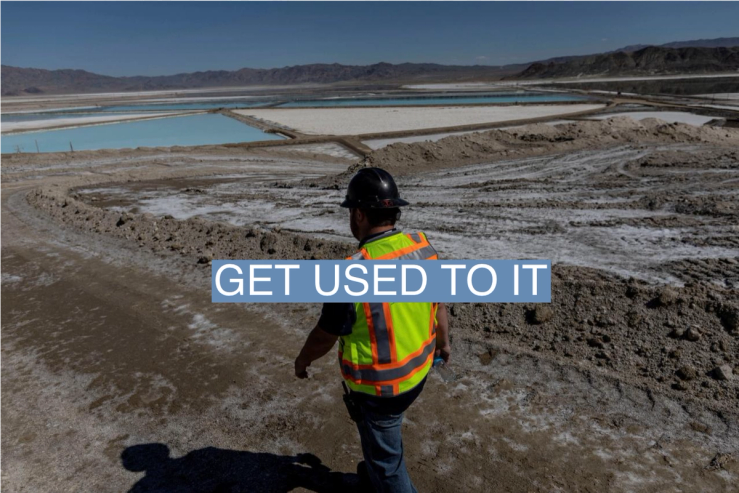The Facts
The Biden administration’s ambivalence toward domestic mining for copper and other minerals works against its own climate goals, and sets the U.S. up for long-term reliance on China, a new book argues.
In The War Below, longtime Reuters energy correspondent Ernest Scheyder chronicles the booming global demand for lithium, copper, rare earths, and the myriad other metals and minerals that are essential for electric vehicle batteries, grid transmission cables, solar panels, and other energy transition hardware. Ubiquitous consumer electronics have already driven a massive increase in demand for these minerals in the past two decades. Fighting climate change will require a whole lot more: A typical EV motor, for example, requires a mile of copper wiring and nearly 20 pounds of lithium. The International Energy Agency projects that by 2040, global copper demand will be three times higher than today; lithium demand will be 42 times higher. That means the phaseout of fossil fuels will require a massive increase in mining.
In this article:
Tim’s view
Scheyder’s book does a good job of homing in on the series of uncomfortable, but unavoidable, choices and trade-offs that now face Western governments and voters: Between clean energy goals on one hand, and the harms of large-scale mining — to natural ecosystems and to culturally significant places, especially for Indigenous peoples — on the other.
Improved recycling, and changes to technology (batteries that rely on readily-available sodium instead of lithium, for example) can somewhat lessen the need for new mines. But new mines are inevitable — the only question is whose backyard they’re going to despoil. Historically, the U.S. has been willing to export most of that harm overseas, mostly to countries in Latin America and Africa. But if the U.S. is serious about ditching fossil fuels, and especially about turning the energy transition into an opportunity for domestic job creation and reindustrialization, then Americans need to prepare for more mining in their backyards.
“I wanted readers in the U.S. to realize the era of us relying on places we will never visit or never see for the building blocks of our everyday lives is essentially over,” Scheyder told Semafor. “Where did the cobalt come from in this battery? Did a seven-year-old take it out of the ground in the Congo? All of us recoil at that. That’s horrible. But is the answer then to produce more cobalt with higher ESG standards in Western countries? I would argue yes — and so we have to grapple with that as well.”
As a journalist who has covered climate impacts across the globe for more than a decade, I find Scheyder’s argument compelling. The harms of climate change and of reliance on fossil fuels are so severe, systemic, and widespread that localized land degradation and pollution from mining seem comparatively manageable. One of Scheyder’s chapters focuses on a proposed lithium mine in Nevada that has been held up because of the presence of an endangered flower. How many plant and animal species are at risk of extinction because of climate change? That’s not to say that every proposed mine should get an automatic green light, especially since it is very often Indigenous and low-income communities whose neighborhoods and sacred places sit are at risk of disruption and destruction. But far more marginalized communities and special places the world over are at risk from climate impacts.
As Scheyder documents, U.S. politicians have so far failed to find a way of balancing these concerns. Republican lawmakers have been too willing to prioritize mining companies’ desires at the expense of local communities, while the Biden administration has tried so hard to placate both sides that the result has been inertia. And that’s what the planet can least afford at this moment, given that mines can take a decade or more to open. A lack of progress toward new critical mineral mining today virtually guarantees a longer lifespan for fossil fuels, with all their attendant global harms. Charting a more effective and equitable path forward on mining will require compromises on all sides.
The View From Rhyolite Ridge
This conversation has been edited for length and clarity.
Semafor: Before you were on the critical minerals beat, you were covering the fracking boom in North Dakota — how does this new gold rush compare to that one?
Scheyder: When I covered oil and gas, I noticed that people tend to usually fall into one of two camps when it comes to oil: They would say ‘Yes, we support the oil industry, it’s important for the economy,’ or ‘No, oil companies are destroying the planet.’ When I switched to critical minerals, I rarely found any opposition. Who doesn’t like an iPhone, or a Tesla, or all these other devices powered by lithium-ion batteries? But the rub comes when you say, okay, where are actually going to get supplies of cobalt, lithium, nickel, and rare earths? In order to get to the Paris Accord carbon goals, we’re going to have gargantuan increases in the mining of all these critical minerals. And once I started chronicling proposed projects across the U.S. and elsewhere in the world, I saw all this opposition to the mines, and when you start to add that up you really begin to question where we’re going to get these supplies. So the question I want to bring the audience here is, if we want this energy transition, what are the choices we’re willing to make?
Semafor: This really feels like a central tension in the energy transition — to what extent are we willing to damage places with environmental or cultural significance by mining, for the sake of conserving other places that are being ravaged by climate change impacts.
Scheyder: Right now, we’re not actually having that discussion at all en masse. I guess you could say indecision is a choice, but it’s certainly not a productive choice. But we need to wrestle more with the idea that some places may be too special to mine, and we’re not really debating that right now. I tell this story about the proposed Resolution Copper project in Arizona, an hour east of Phoenix. It’s enough copper to supply about a quarter of the U.S. copper needs. Unfortunately, on the surface is a Native American holy site that many of the San Carlos Apache people have worshiped at for hundreds of years. They make this stark comparison, like what if you found a giant supply of lithium underneath St. Peter’s Basilica? So the project is in a bit of a stasis.
We didn’t have these collective questions circulating 150 years ago as the Industrial Revolution took off and we started using a lot more fossil fuels. And we got a lot more pollution, we got a lot more armed conflicts around petroleum, we got a cartel that controls a huge chunk of the world’s petroleum production. If we’re not having those collective discussions now, during this energy transition, we’re gonna make those same mistakes, and come 100 years from now we’ll be having different conflicts.
Semafor: How has the Biden administration in particular been grappling with this?
Scheyder: There are multiple examples of one arm of the U.S. federal government seemingly not knowing or not caring what another arm of the US federal government is doing. A great example is the Rhyolite Ridge lithium deposit. There’s a rare flower found nowhere else on the planet that lives above a deposit of lithium, about 200 miles north of Las Vegas. The government has laid out ambitious EV adoption targets, so that requires an increase in lithium production. So the U.S. Department of Energy starts discussing production with this company. Meanwhile, a conservation group is saying this flower should be declared endangered, and starts that process with the Fish and Wildlife Service. One part of the government is saying this flower should be declared endangered, and another part saying we’re going to lend hundreds of millions of dollars to the company that would like to develop this mine. Is the White House overseeing all of this? Same thing with Resolution Copper, which President Biden put on hold, and the Twin Metals, copper, nickel, and cobalt project in northern Minnesota that Biden also essentially killed. President Trump killed the Pebble Mine project in Alaska, because that’s where his son and Tucker Carlson enjoy fishing.
So it causes a lot of whiplash, not only among people in the industry, but for everyday Americans who say, ‘We hear you on these broad climate goals, but in order to get there, you need to have more mining.’ We can’t have the Inflation Reduction Act without mining, there’s just no way around it. And these projects, you don’t just flip a switch and have them open, they do take at least a decade or more to bring online.
Semafor: And mining is key to understanding U.S. relations with China. China was very prescient, in a way, in taking a commanding position in rare earths and other minerals well before the full scale of their commercial value was well understood.
Scheyder: That’s right, there are parts of the world, namely China, that are willing to use their control of these critical minerals as economic weapons. China definitely recognized the importance of these areas as early as the 1980s. Chinese leaders recognized that Saudi Arabia has oil but China has rare earths. So they were very focused on collecting not only the institutional know-how, but also the physical infrastructure around rare earths and other minerals and metals. This was before the energy transition was really even thought of, but if you’re making any piece of industrial equipment, for example anything to do with stainless steel, obviously, you have to access a lot of nickel. Whereas in the U.S., for a long time, mining has been an afterthought, and or just focused on coal mining. It was not a sexy industry to go into. So what’s going on in Washington right now is not necessarily to reduce China’s prowess in this area, but more to increase the United States and allied nations’ ability to have more production of their own.
Semafor: In your reporting on the companies involved here, like Vale or Rio Tinto, do you see them doing enough to improve their social and environmental practices, or just paying lip service to ESG?
Scheyder: They definitely recognize that cleaning up their own operations is in their best interest. There’s a slow movement in trying to have their mining vehicles go all-electric and be autonomous, and a lot more mining sites are using solar now than in the past. And the safety standards are much higher than they were a hundred years ago. At the same time, you have situations like the Brumadinho tailings dam collapse in Brazil a few years ago that killed 300 people. That was owned by Vale, and had been known for a while to be structurally unsound, and Vale ignored it. This reinforced a lot of fears that people have about mining. So I hope that culture is changing. We’ll see.
Notable
- China’s largest mining firms are taking advantage of low battery metal prices to acquire smaller rivals, further consolidating their grip on the global supply chains for lithium and cobalt.


